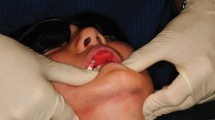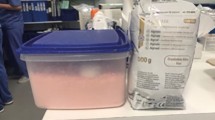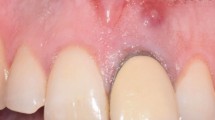Abstract
Diagnosis, disease control and prevention are the precursors to successful definitive restorative treatment of pathological tooth wear. This case series illustrates how proposed key clinical features can influence treatment complexity and provide the clinician with a logical sequence of treatment options for definitive management of tooth wear.
Key points
-
Identification of the aetiology, risk management and prevention are fundamental steps before definitive restorative treatment.
-
Treatment should be patient-centred, evidence-based and aim to minimise the lifelong restorative burden.
-
Definitive restorative treatment complexity is illustrated in relation to key clinical factors.
This is a preview of subscription content, access via your institution
Access options
Subscribe to this journal
Receive 24 print issues and online access
$259.00 per year
only $10.79 per issue
Buy this article
- Purchase on Springer Link
- Instant access to full article PDF
Prices may be subject to local taxes which are calculated during checkout


















Similar content being viewed by others
References
Li M H M, Bernabé E. Tooth wear and quality of life among adults in the United Kingdom. J Dent 2016; 55: 48-53.
Smith B G, Bartlett D W, Robb N D. The prevalence, etiology and management of tooth wear in the United Kingdom. J Prosthet Dent 1997; 78: 367-372.
O'Toole S, Pennington M, Varma S, Bartlett D W. The treatment need and associated cost of erosive tooth wear rehabilitation - a service evaluation within an NHS dental hospital. Br Dent J 2018; 224: 957-961.
Mehta S B, Loomans B A C, Banerji S, Bronkhorst E M, Bartlett D. An investigation into the impact of tooth wear on the oral health related quality of life among adult dental patients in the United Kingdom, Malta and Australia. J Dent 2020; 99: 103409.
Loomans B, Opdam N J, Attin T et al. Severe Tooth Wear: European Consensus Statement on Management Guidelines. J Adhes Dent 2017; 19: 111-119.
Bartlett D, Dugmore C. Pathological or physiological erosion - is there a relationship to age? Clin Oral Investig 2008; DOI: 10.1007/s00784-007-0177-1.
Van't Spijker A, Rodriguez J M, Kreulen C M, Bronkhorst E M, Bartlett D W, Creugers N H J. Prevalence of tooth wear in adults. Int J Prosthodont 2009; 22: 35-42.
Newsome P, Smales R, Yip K. Oral diagnosis and treatment planning: part 1. Introduction. Br Dent J 2012; 213: 15-19.
Jordão H W T, Coleman H G, Kunzmann A T, McKenna G. The association between erosive toothwear and gastro-oesophageal reflux-related symptoms and disease: A systematic review and meta-analysis. J Dent 2020; 95: 103284.
Hemmings K, Truman A, Shah S, Chauhan R. Tooth Wear Guidelines for the BSRD. Part 1: Aetiology, Diagnosis and Prevention. Dent Update 2018; 45: 483-495.
Ahmed K E. Management of Tooth Wear: A Holistic, Dental, Medical, and Mental Healthcare Approach. Prim Dent J 2016; 5: 35-37.
Mehta S B, Bronkhorst E M, Crins L, Huysmans M-C D N J, Wetselaar P, Loomans B A C. A comparative evaluation between the reliability of gypsum casts and digital greyscale intra-oral scans for the scoring of tooth wear using the Tooth Wear Evaluation System (TWES). J Oral Rehabil 2021; 48: 678-686.
Wetselaar P, Wetselaar-Glas M J M, Koutris M, Visscher C M, Lobbezoo F. Assessment of the amount of tooth wear on dental casts and intra-oral photographs. J Oral Rehabil 2016; 43: 615-620.
Bartlett D, Ganss C, Lussi A. Basic Erosive Wear Examination (BEWE): a new scoring system for scientific and clinical needs. Clin Oral Investig 2008; DOI: 10.1007/s00784-007-0181-5.
Schlenz M A, Schlenz M B, Wöstmann B, Jungert A, Ganss C. Intraoral scanner-based monitoring of tooth wear in young adults: 12-month results. Clin Oral Investig 2022; 26: 1869-1878.
Addy L, Thomas M, Cummings C, King E. Removable Prosthodontics for the Management of Severe Toothwear. Dent Update 2020; 47: 396-404.
Milosevic A, Burnside G. The survival of direct composite restorations in the management of severe tooth wear including attrition and erosion: A prospective 8-year study. J Dent 2016; 44: 13-19.
Redman C D J, Haemmings K W, Good J A. The survival and clinical performance of resin-based composite restorations used to treat localised anterior tooth wear. Br Dent J 2003; 194: 566-572.
Hemmings K W, Darbar U R, Vaughan S. Tooth wear treated with direct composite restorations at an increased vertical dimension: Results at 30 months. J Prosthet Dent 2000; 83: 287-293.
Bidra A S, Daubert D M, Garcia L T et al. Clinical practice guidelines for recall and maintenance of patients with tooth-borne and implant-borne dental restorations. J Am Dent Assoc 2016; 147: 67-74.
O'Toole S, Khan M, Patel A et al. Tooth wear risk assessment and care-planning in general dental practice. Br Dent J 2018; 224: 358-362.
Sterenborg B A M M, Bronkhorst E M, Wetselaar P, Lobbezoo F, Loomans B A C, Huysmans M-C D N J M. The influence of management of tooth wear on oral health-related quality of life. Clin Oral Investig 2018; 22: 2567-2573.
Patel J, Baker S R. Is toothwear associated with oral health related quality of life in adults in the UK? Community Dent Health 2020; 37: 174-179.
Ahmed K E, Murray C A, Whitters C J. A prospective survey of secondary care tooth wear referrals: demographics, reasons for concern and referral outcomes. Br Dent J 2014; DOI: 10.1038/sj.bdj.2014.179.
Tjan A H, Miller G D, The J G. Some esthetic factors in a smile. J Prosthet Dent 1984; 51: 24-28.
Giannuzzi N J, Motlagh S D. Full Mouth Rehabilitation Determined by Anterior Tooth Position. Dent Clin North Am 2015; 59: 609-621.
Ward D H. Proportional Smile Design: Using the Recurring Esthetic Dental Proportion to Correlate the Widths and Lengths of the Maxillary Anterior Teeth with the Size of the Face. Dent Clin North Am 2015; 59: 623-638.
Vig R G, Brundo G C. The kinetics of anterior tooth display. J Prosthet Dent 1978; 39: 502-504.
Setchell D. Tooth surface loss: Conventional crown and bridgework. Br Dent J 1999; 187: 68-74.
Varma S, Preiskel A, Bartlett D. The management of tooth wear with crowns and indirect restorations. Br Dent J 2018; 224: 343-347.
Antoniazzi R P, Fischer L S, Balbinot C E A, Antoniazzi S P, Skupien J A. Impact of excessive gingival display on oral health-related quality of life in a Southern Brazilian young population. J Clin Periodontol 2017; 44: 996-1002.
Wetselaar P, Wetselaar-Glas M J M, Katzer L D, Ahlers M O. Diagnosing tooth wear, a new taxonomy based on the revised version of the Tooth Wear Evaluation System (TWES 2.0). J Oral Rehabil 2020; 47: 703-712.
Sivasithamparam K, Harbrow D, Vinczer E, Young W G. Endodontic sequelae of dental erosion. Aust Dent J 2003; 48: 97-101.
Marro F, O'Toole S, Bernabé E, Bartlett D, Aránguiz V. Associated risk factors with quantitative erosive tooth wear progression. J Dent 2022; 123: 104179.
Kanaan M, Brabant A, Hara A T, Carvalho J C. Diagnosis, risk assessment, and treatment decisions for tooth wear in daily practice: a case presentation survey among Belgian dentists. Eur J Oral Sci 2021; DOI: 10.1111/eos.12764.
Swift J E Jr, Perdigão J, Heymann H O. Bonding to enamel and dentin: a brief history and state of the art, 1995. Quintessence Int 1995; 26: 95-110.
Wiegand A, Lechte C, Kanzow P. Adhesion to eroded enamel and dentin: systematic review and meta-analysis. Dent Mater 2021; 37: 1845-1853.
McDonald A, Setchell D. Developing a tooth restorability index. Dent Update 2005; 32: 343-348.
Dawood A, Patel S. The Dental Practicality Index - assessing the restorability of teeth. Br Dent J 2017; 222: 755-758.
Al-Khayatt A S, Ray-Chaudhuri A, Poyser N J et al. Direct composite restorations for the worn mandibular anterior dentition: a 7-year follow-up of a prospective randomised controlled split-mouth clinical trial. J Oral Rehabil 2013; 40: 389-401.
Poyser N J, Briggs P F A, Chana H S, Kelleher M G D, Porter R W J, Patel M M. The evaluation of direct composite restorations for the worn mandibular anterior dentition - clinical performance and patient satisfaction. J Oral Rehabil 2007; 34: 361-376.
Mehta S B, Bronkhorst E M, Lima V P et al. The effect of pre-treatment levels of tooth wear and the applied increase in the vertical dimension of occlusion (VDO) on the survival of direct resin composite restorations. J Dent 2021; 111: 103712.
Maxwell A W, Blank L W, Pelleu G B Jr. Effect of crown preparation height on the retention and resistance of gold castings. Gen Dent 1990; 38: 200-202.
Sorensen J A, Engelman M J. Ferrule design and fracture resistance of endodontically treated teeth. J Prosthet Dent 1990; 63: 529-536.
Abbott P V. Assessing restored teeth with pulp and periapical diseases for the presence of cracks, caries and marginal breakdown. Aust Dent J 2004; 49: 33-39.
Martins B M C, Silva E J N L, Ferreira D M T P, Reis K R, Fidalgo T K D S. Longevity of defective direct restorations treated by minimally invasive techniques or complete replacement in permanent teeth: A systematic review. J Dent 2018; 78: 22-30.
Tada S, Allen P F, Ikebe K, Zheng H, Shintani A, Maeda Y. The Impact of the Crown-Root Ratio on Survival of Abutment Teeth for Dentures. J Dent Res 2015; DOI: 10.1177/0022034515589710.
Stanley H R, Pereira J C, Spiegel E, Broom C, Schultz M. The detection and prevalence of reactive and physiologic sclerotic dentin, reparative dentin and dead tracts beneath various types of dental lesions according to tooth surface and age. J Oral Pathol 1983; 12: 257-289.
Saunders W P, Saunders E M. Prevalence of periradicular periodontitis associated with crowned teeth in an adult Scottish subpopulation. Br Dent J 1998; 185: 137-140.
Cheung G S P, Lai S C N, Ng R P Y. Fate of vital pulps beneath a metal-ceramic crown or a bridge retainer. Int Endod J 2005; 38: 521-530.
Gulamali A B, Hemmings K W, Tredwin C J, Petrie A. Survival analysis of composite Dahl restorations provided to manage localised anterior tooth wear (ten-year follow-up). Br Dent J 2011; DOI: 10.1038/sj.bdj.2011.683.
Ahmed K E, Murbay S. Survival rates of anterior composites in managing tooth wear: systematic review. J Oral Rehabil 2016; 43: 145-153.
Gough M B, Setchell D J. A retrospective study of 50 treatments using an appliance to produce localised occlusal space by relative axial tooth movement. Br Dent J 1999; 187: 134-139.
Gross M D, Nissan J, Ormianer Z, Dvori S, Shifman A. The effect of increasing occlusal vertical dimension on face height. Int J Prosthodont 2002; 15: 353-357.
Hellsing G. Functional adaptation to changes in vertical dimension. J Prosthet Dent 1984; 52: 867-870.
Carlsson G E, Ingervall B, Kocak G L. Effect of increasing vertical dimension on the masticatory system in subjects with natural teeth. J Prosthet Dent 1979; 41: 284-289.
Wazani B E, Dodd M N, Milosevic A. The signs and symptoms of tooth wear in a referred group of patients. Br Dent J 2012; DOI: 10.1038/sj.bdj.2012.840.
Calvert G. Guided surgical crown lengthening. Dent Update 2019; 46: 596-597.
Bergenholtz G, Nyman S. Endodontic complications following periodontal and prosthetic treatment of patients with advanced periodontal disease. J Periodontol 1984; 55: 63-68.
Abduo J, Lyons K M. Interdisciplinary interface between fixed prosthodontics and periodontics. Periodontol 2000 2017; 74: 40-62.
Author information
Authors and Affiliations
Contributions
Paul Guerino Cocozza and Gareth Calvert: conceptualisation; writing - original draft; writing - review and editing; and visualisation. Khaled Elsayed Ahmed: writing - original draft and writing - review and editing.
Corresponding author
Ethics declarations
The authors declare no conflicts of interest.
Rights and permissions
About this article
Cite this article
Calvert, G., Cocozza, P. & Elsayed Ahmed, K. Clinical factors to consider in definitive treatment planning for patients with tooth wear. Br Dent J 234, 375–384 (2023). https://doi.org/10.1038/s41415-023-5618-y
Received:
Revised:
Accepted:
Published:
Issue Date:
DOI: https://doi.org/10.1038/s41415-023-5618-y



